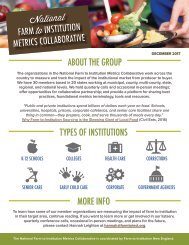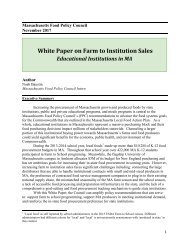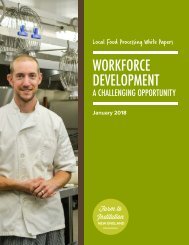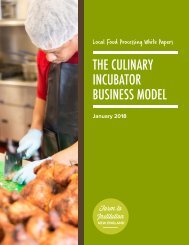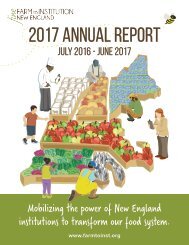Northern Girl Case Study
You also want an ePaper? Increase the reach of your titles
YUMPU automatically turns print PDFs into web optimized ePapers that Google loves.
Farm to<br />
Institution<br />
NEW ENGLAND<br />
Food Processing <strong>Case</strong> <strong>Study</strong><br />
JANUARY 2017<br />
THIRD PARTY AUDIT OPENS THE<br />
DOORS TO INCREASED SALES<br />
FEATURED FACILITY: NORTHERN GIRL<br />
By Nathaniel Brooks<br />
To learn more about <strong>Northern</strong> <strong>Girl</strong>, visit http://northerngirlmaine.com<br />
Find this case study and others on our website: www.farmtoinstitution.org/case-studies<br />
FOOD PROCESSORS COMMUNITY OF PRACTICE CASE STUDY | NORTHERN GIRL PAGE 1
OVERVIEW<br />
Name: <strong>Northern</strong> <strong>Girl</strong><br />
Location: Van Buren, ME<br />
Opened: 2011<br />
Business Model: for-profit (LLC)<br />
Staff: six full-time, 20 part-time seasonally (Sept.-May)<br />
Facility at a Glance:<br />
• 4k square foot kitchen<br />
• Fresh and frozen lines<br />
• High-volume washing, peeling, chopping<br />
• Conventional and Certified Organic<br />
Annual Revenue: approx. $500,000<br />
Production Volume: approx. 10,000 pounds per week<br />
Local Farms: Sources from 12 growers; small Amish<br />
farms to many hundred acre operations. GAP<br />
certification required.<br />
Services: value-added processing of locally grown foods<br />
More Information:<br />
<strong>Northern</strong> <strong>Girl</strong> was founded with the mission “to<br />
bring opportunity to growers in Maine’s largest and<br />
most remote county.” The business aims to support<br />
the local economy by helping area farmers create<br />
value-added products. By rebuilding Maine’s food<br />
processing infrastructure, <strong>Northern</strong> <strong>Girl</strong> hopes<br />
to keep Maine at the forefront of the local foods<br />
movement. Originally the brainchild of Kate and Jim<br />
Cook, <strong>Northern</strong> <strong>Girl</strong> was eventually started by the<br />
couple’s daughters, Marada and Leah Cook, along<br />
with business partner and general manager Chris<br />
Hallweaver. <strong>Northern</strong> <strong>Girl</strong> opened in 2011 in the<br />
abandoned kitchen of a former air force base. In 2013<br />
the business constructed a new dedicated facility in<br />
partnership with the Town of Van Buren.<br />
KEY TAKEAWAYS<br />
1<br />
2<br />
3<br />
4<br />
5<br />
Foundational systems need to be in<br />
place first.<br />
Outside help can be critical to<br />
success.<br />
The process can be time-consuming<br />
and expensive.<br />
Having third-party certification<br />
provides a level of assurance<br />
important to customers.<br />
A third-party-certified comprehensive<br />
food safety program is a protection<br />
for the company.<br />
See page 7 for more detail<br />
Members of the <strong>Northern</strong> <strong>Girl</strong> processing team<br />
chop parsnips in the new facility.<br />
FOOD PROCESSORS COMMUNITY OF PRACTICE CASE STUDY | NORTHERN GIRL PAGE 2
THE CHALLENGE<br />
<strong>Northern</strong> <strong>Girl</strong> processes a large volume of root crops,<br />
many of them organic, and sells products to both<br />
institutions and commercial chains. Whole Foods,<br />
for example, is a large customer, purchasing from<br />
<strong>Northern</strong> <strong>Girl</strong> to supply numerous store commissary<br />
operations in New England. To ensure the safety of<br />
their food, such operations typically require suppliers<br />
to obtain a certified third-party food safety and<br />
HACCP (Hazard Analysis and Critical Control Point)<br />
plan audit. When <strong>Northern</strong> <strong>Girl</strong> began, many of its<br />
commercial customers were willing to temporarily<br />
waive some of their supplier requirements in order<br />
to obtain the distinctive local products that <strong>Northern</strong><br />
<strong>Girl</strong> was offering. Once <strong>Northern</strong> <strong>Girl</strong> transitioned to<br />
its new dedicated facility, however, staff recognized<br />
that this initial grace period was drawing to a close.<br />
Meanwhile <strong>Northern</strong> <strong>Girl</strong>’s increased efforts to sell to<br />
institutional markets, some of which serve particularly<br />
vulnerable populations such as children or the elderly,<br />
made a comprehensive food safety program an<br />
urgent priority. As Leah Cook explains, “Not having a<br />
certifiable food safety program [was] both a risk to the<br />
company and a barrier to sales.”<br />
THREE LEVELS OF FOOD SAFETY<br />
It should be emphasized that the lack of a certifiable<br />
third-party audit didn’t mean that food produced at<br />
<strong>Northern</strong> <strong>Girl</strong> was unsafe. The processing facility<br />
had been inspected and licensed by the Maine<br />
Department of Agriculture and the Food and Drug<br />
Administration (FDA), staff were trained on the<br />
fundamentals of food safety, and a comprehensive<br />
set of standard operating procedures (SOPs) was in<br />
place. <strong>Northern</strong> <strong>Girl</strong> was operating following all the<br />
principles of good manufacturing practices (GMPs)<br />
including temperature controls, receiving guidelines,<br />
employee hygiene and safety training, etc. HACCP is<br />
considered the next level of rigor in food safety and<br />
is standard practice for large processors. <strong>Northern</strong><br />
<strong>Girl</strong> staff had developed a set of HACCP plans for<br />
their initial, much smaller, facility but these needed<br />
to be updated and expanded. This was particularly<br />
challenging because HACCP plans were not required<br />
for vegetable processors under FDA regulation<br />
and very little guidance for processors was publicly<br />
available. In addition to this lack of information, the<br />
<strong>Northern</strong> <strong>Girl</strong> team, still in the midst of operational<br />
transitions, lacked the bandwidth to update their<br />
HACCP plans and develop an overarching food safety<br />
management system.<br />
FOOD PROCESSORS COMMUNITY OF PRACTICE CASE STUDY | NORTHERN GIRL PAGE 3
CLOSING THE CAPACITY GAP<br />
With the move to the new larger production<br />
facility, then General Manager Chris Hallweaver<br />
was straddling two roles: sales (a process that<br />
increasingly included the response “we’re working<br />
on it” when buyers asked about food safety) and<br />
day-to-day plant operations. The latter would have<br />
been hard enough had it been a matter of business<br />
as usual, but with the shift to the new production<br />
facility had come new equipment and the chance to<br />
experiment with new products, an iterative process<br />
that was still underway. Hallweaver is frank about<br />
the challenge, pointing to lack of bandwidth as<br />
a major barrier to getting HACCP plans updated<br />
and documentation in place. Fortunately, it was a<br />
solvable problem.<br />
In the spring of 2015 <strong>Northern</strong> <strong>Girl</strong> hired Carl<br />
Pratt to take over as plant manager, removing the<br />
burden of operations from Hallweaver and letting<br />
him concentrate on building and maintaining sales<br />
relationships. Getting a comprehensive food safety<br />
management system in place was “a big part” of the<br />
new plant manager’s job description. Leah Cook,<br />
who had been working at Crown o’ Maine Organic<br />
Cooperative, transitioned in September 2015 to<br />
part-time work at <strong>Northern</strong> <strong>Girl</strong>. Cook, who had<br />
previously been trained on HACCP principles and<br />
was Seafood HACCP certified in her previous job,<br />
was able to bring her training to bear in support of<br />
the effort. The organization also successfully applied<br />
for technical assistance funding from The Fair Food<br />
Fund, an impact investment fund created in 2012<br />
by the Fair Food Network with the mission to “build<br />
robust regional food systems—systems that support<br />
the health of people, the environment, and the<br />
economy.” This assistance, in the form of a $10,000<br />
grant, was used to hire an external consultant<br />
to work with Cook and Pratt on a food safety<br />
management system.<br />
DEVELOPING A COMPREHENSIVE FOOD SAFETY<br />
MANAGEMENT SYSTEM<br />
To understand the process of developing <strong>Northern</strong><br />
<strong>Girl</strong>’s food safety management system, it’s helpful<br />
first to appreciate just what a “certifiable” standard<br />
for food safety means in the world of food<br />
manufacturing. Until recently, retailers who wanted<br />
to ensure the quality of the food they purchased<br />
from suppliers resorted to in-house standards and<br />
periodic supply chain audits. The proliferation of<br />
these in the 1990s placed an increasing burden on<br />
food manufacturers. At the same time, a number<br />
of well-publicized outbreaks of food-borne illness<br />
(including the 1993 outbreak of E. coli traced to<br />
undercooked hamburgers at Jack in the Box and<br />
a 1998 Listeriosis outbreak traced to hot dogs<br />
and cold cuts made by the Sara Lee Corporation)<br />
had reduced consumer confidence in the safety<br />
of the food supply. In 2000, global food company<br />
executives convened at the Consumer Goods Forum<br />
(CGF; at that time called CIES, the International<br />
Committee of Food Chains) and launched the The<br />
Global Food Safety Initiative (GFSI). GFSI provides<br />
a global, peer-reviewed benchmarking of various<br />
food safety schemes with the goal of ensuring that<br />
once a manufacturer was certified, the certification<br />
would be accepted everywhere. A manufacturer can<br />
choose the GFSI-recognized food safety scheme<br />
that best fits their product line, develop their food<br />
safety management system, and receive a third-party<br />
FOOD PROCESSORS COMMUNITY OF PRACTICE CASE STUDY | NORTHERN GIRL PAGE 4
audit by an approved auditor. Because the auditor<br />
is approved by the scheme owner and the scheme<br />
is recognized by GFSI as satisfying its food safety<br />
benchmarks, the food safety management system is<br />
certifiable against the GFSI standard and should be<br />
accepted anywhere.<br />
The reality of managing something as complex<br />
as this multi-tiered system is never as simple in<br />
practice as in theory. Unlike other many other food<br />
categories, minimally processed produce did not<br />
require HACCP plans under FDA regulation until<br />
new rules promulgated under the Food Safety<br />
Modernization Act (FSMA) took effect. Because<br />
this requirement was not yet in place at the time<br />
<strong>Northern</strong> <strong>Girl</strong> undertook the development of their<br />
food safety management system, compiled guidance<br />
for industry and examples from similar companies<br />
weren’t available. This made finding an outside<br />
expert with deep expertise in produce, access to<br />
the peer-reviewed scientific literature, and strong<br />
contacts within the regulatory world a critical task.<br />
After many referrals and interviews, the team decided<br />
to contract with Julius Pataki of Quality Consulting<br />
Services, Inc. from Prince Edward Island in Canada.<br />
Even after identifying and enlisting a highly-qualified<br />
consultant, <strong>Northern</strong> <strong>Girl</strong> ran into several bumps<br />
in the road. An anti-terrorism clause in the Fair<br />
Food Fund financing forbade payments to foreign<br />
contractors, meaning the team needed to find a third<br />
entity to serve as a pass-through for the funding.<br />
This increased costs and pushed back contract<br />
negotiations by several months. During the fall of<br />
2015 the team began feeding Pataki documentation<br />
on their existing processes. In the course of doing so<br />
they realized that additional position-specific training<br />
was needed for staff and further work was necessary<br />
to strengthen the plant manager transition. During<br />
this period some of the previous season’s staff<br />
were not rehired, or returned briefly before they<br />
decided not to come back. These transitions were<br />
an unsurprising side-effect of the increasingly stable<br />
and systematic operations, a growing culture of<br />
accountability, and some staff’s unwillingness to<br />
adjust to a more routine work environment. The<br />
upshot, however, was that the turnover required<br />
training new staff even as existing staff took on a<br />
higher workload.<br />
During an initial site visit, held December 14-<br />
15, 2015, Pataki worked with the <strong>Northern</strong> <strong>Girl</strong><br />
managment team to train all staff on the basics of<br />
Good Manufacturing Practices (GMPs) and put in<br />
place the systems necessary to begin collecting<br />
documentation of the food safety system. Following<br />
the first site visit, the management team focused<br />
on upgrading their documentation and continued<br />
to work with Pataki to review, revise, and capture in<br />
writing all sanitation procedures. A second site visit,<br />
held February 22-23, 2016, focused on implementing<br />
a traceability program. During the visit Pataki trained<br />
staff on recall procedures and led a mock recall<br />
exercise, as well as implemented the critical control<br />
point recordkeeping that would support the final<br />
HACCP plans.<br />
Following the second site visit by Pataki, <strong>Northern</strong><br />
<strong>Girl</strong> management had two months to prepare for<br />
their April 22nd audit. The team worked through<br />
a 20-item punch list of outstanding issues,<br />
purchased needed equipment and trained staff on<br />
the revised systems. In addition to staff time, two<br />
major expenses encountered were the need for<br />
new compost control bins (<strong>Northern</strong> <strong>Girl</strong> generates<br />
significant peelings and other processing waste<br />
which must be stored to prevent pest attraction and<br />
microbial growth) and an ATP tester. The latter, which<br />
detects biological residues on any surface, is a quick<br />
and reliable means of assessing the efficacy of a<br />
facility’s sanitation SOPs. While it was an expensive<br />
purchase ($1,727) it gave the team the ability to test<br />
FOOD PROCESSORS COMMUNITY OF PRACTICE CASE STUDY | NORTHERN GIRL PAGE 5
environmental biological loads in-house and ensure<br />
the sanitation of their food processing surfaces.<br />
During a final site visit, shortly prior to the audit,<br />
Pataki and <strong>Northern</strong> <strong>Girl</strong> management rolled out<br />
the completed HACCP plans, trained all staff in the<br />
overall framework, and trained key staff in-depth<br />
on the HACCP plan and specific critical control<br />
points (CCPs) and control measures. Cook notes<br />
that it was only Pataki’s depth of experience that<br />
allowed this unconventional timeline, in which CCP<br />
record-keeping began prior to finalization of the<br />
full HACCP plans, to work. If his initial assessment<br />
had missed any CCP required by the final plans,<br />
additional months of recordkeeping would have<br />
been necessary ahead of the final audit.<br />
Despite challenges along the way and their<br />
unconventional timeline the hard work of the <strong>Northern</strong><br />
<strong>Girl</strong> team paid off. On April 22, after spending all day<br />
with the auditor from Primus Azzuzle, they received an<br />
initial score of 97%, with only eight nonconformance<br />
reports. After submitting corrective actions, the<br />
final score achieved and documented on their audit<br />
certificate was 99%, an experience ranked by Pataki<br />
as “one of the top in his career.”<br />
AFTER THE AUDIT<br />
As Leah Cook puts it, although the process “started<br />
later, took longer, and was more expensive than<br />
originally anticipated” <strong>Northern</strong> <strong>Girl</strong> staff feel having<br />
a rigorous food safety management system in<br />
place was well worth the work. Plant staff members<br />
are confident in their knowledge of food safety,<br />
proud of their achievement, and active participants<br />
in managing the food safety system. Although<br />
the recordkeeping, period reviews, inspections,<br />
and mock recalls are at times burdensome (Cook<br />
estimates approximately 2000 hours of additional<br />
staff time per year) the investment means <strong>Northern</strong><br />
<strong>Girl</strong> is already in compliance with the new FSMA<br />
regulations, well ahead of the November 2018<br />
deadline for small processors.<br />
pack of baby beets is in the works) and expand sales<br />
relationships to other chains, including Hannaford,<br />
Wegmans, and Trader Joe’s, all of which require 3rdparty<br />
food safety audits of their suppliers. The ability<br />
to expand their customer base is critical to <strong>Northern</strong><br />
<strong>Girl</strong>’s long-term success; with a rigorous food safety<br />
system in place they can now do so with confidence.<br />
Most importantly, the rigorous food safety<br />
management system means the organization can<br />
be confident that control measures are in place and<br />
that the system dictates the vigilance necessary<br />
to prevent unsafe food leaving their plant. When a<br />
food safety scandal hit Whole Foods, their largest<br />
customer, in June 2016 (Woolhouse, Megan “FDA<br />
inspectors find evidence of Listeria at Whole Foods<br />
Kitchen” The Boston Globe, 14 Jun 2016) <strong>Northern</strong><br />
<strong>Girl</strong> could rest secure in the knowledge that<br />
increased scrutiny from their buyers wouldn’t be a<br />
problem. This confidence has let <strong>Northern</strong> <strong>Girl</strong> begin<br />
exploring additional value-added products (a retail<br />
FOOD PROCESSORS COMMUNITY OF PRACTICE CASE STUDY | NORTHERN GIRL PAGE 6
KEY TAKEAWAYS<br />
1<br />
2<br />
3<br />
4<br />
5<br />
Foundational systems need to be in place first.<br />
Before HACCP plans can be implemented, a business’s basic operational systems need<br />
to be stable and functioning smoothly, the fundamentals of Good Manufacturing Practices<br />
need to be met, written procedures in place, staff trained, and recordkeeping a regular,<br />
ongoing process.<br />
Outside help can be critical to success.<br />
Lack of bandwidth was a major limiting factor that delayed the beginning of the process<br />
from August 2014, when <strong>Northern</strong> <strong>Girl</strong> moved into the new facility, to the spring of<br />
2015, when management began the search for an external consultant. Without Pataki’s<br />
expertise, updating HACCP plans, implementing a recall system, and many of the other<br />
aspects of putting in place a comprehensive food safety management system would have<br />
been difficult or impossible.<br />
The process can be time-consuming and expensive.<br />
The cost of additional equipment was minor compared to the staff time spent on<br />
developing and reviewing systems, training, and recordkeeping. Cook’s time to manage<br />
the project from inception to audit, for example, totaled 386 hours; more than double the<br />
team’s initial estimate.<br />
Having third-party certification provides a level of<br />
assurance important to customers.<br />
Large supermarket chains, cognizant of the need to manage supply chain risk, won’t<br />
begin serious sales discussions for lightly-processed products without the knowledge that<br />
a supplier’s facility has passed a third-party audit.<br />
A third-party-certified comprehensive food safety<br />
program is a protection for the company.<br />
It mitigated the enormous risk an outbreak of foodborne illness would pose to the<br />
company by putting in place rigorous measures of prevention and control. By the nature<br />
of its requirements it also stabilized and reinforced quality and operational standards.<br />
Finally, it put the company in compliance with FSMA long before the implementation<br />
dates, avoiding any disruption of operations.<br />
Find this case study and others on our website: www.farmtoinstitution.org/case-studies<br />
Learn more about Farm to Institution New England at www.farmtoinstitution.org<br />
FOOD PROCESSORS COMMUNITY OF PRACTICE CASE STUDY | NORTHERN GIRL PAGE 7




